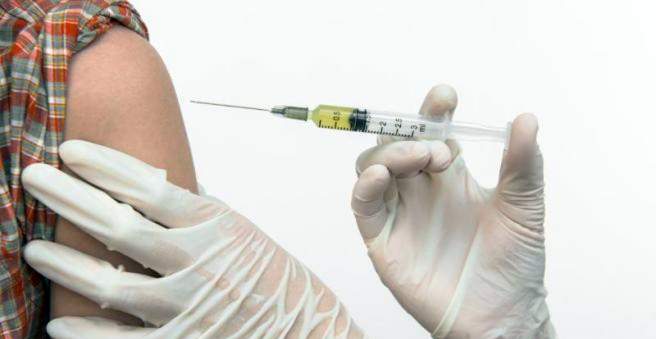Until the end of the 20th century (1998) there was a tuberculosis vaccine. However, the Standing Vaccination Commission (STIKO) of the Robert Koch Institute (RKI) does not recommend vaccinations anymore; on the one hand, there were always complications in the past; on the other hand, there are only a few tuberculosis cases in Germany.

The vaccine
The tuberculosis vaccine uses an attenuated mycobacterial strain. At the beginning of the 20th century, the French scientists Albert Camette and Camille Guérin bred the Mycobacterium bovis, which occurs particularly in cattle. The pathogens multiplied on a special nutrient medium. This reduced the harmfulness of tuberculosis pathogens. In 1921, the two researchers finally developed the tuberculosis vaccine. These are therefore weakened but still living mycobacteria. Therefore, one speaks of a so-called live vaccination. The vaccine was named after its discoverers BCG (Bacillus Calmette-Guérin) vaccine.
Application of the vaccine
The BCG vaccine is injected exclusively into the skin. Medically, this is called an intracutaneous injection. Newborns and infants up to the sixth week of life may be easily vaccinated. However, in children older than six weeks, a Mendel-Mantoux tuberculin test will be performed beforehand. A small dose of the tuberculosis protein tuberculin is injected into the skin. If no or very little reddened induration occurs at this skin site, the test is negative. Only then can these children also be vaccinated.
Whether the tuberculosis vaccine has been successfully performed, shows again the tuberculin test according to Mendel-Mantoux. The test should be positive at the earliest three weeks after vaccination. It shows a clear hardening and redness at the puncture site of the skin. The tuberculin test is still positive years after a successful tuberculosis vaccine. Therefore you should always inform the doctor about vaccinations. If the test is negative, it will be re-vaccinated.
Effectiveness of tuberculosis vaccine
That a BCG vaccine always prevents tuberculosis is unfortunately not the case. It protects neither against infection nor before the spread of the pathogens. Also, the disease course of an infection is only slightly affected in adults. However, studies have shown that vaccination has great benefits in children. Here it protects about 80 percent, especially against severe disease and tuberculosis diseases that spread over the entire body.
However, the efficacy of the BCG vaccine in different countries of the world and their regions varies. A paper published in 1995 by the London School of Hygiene and Tropical Medicine compared the benefits of tuberculosis vaccine worldwide. The vaccine is therefore the most ineffective, especially in regions of Africa, Latin America and Asia. The reasons are seen on the one hand in the different environmental situations such as city or country; On the other hand, the quality of the studies carried out at the respective sites, which were used for comparison, was very different.
Side effects of tuberculosis vaccine
Because this vaccine uses tuberculosis, it can lead to TB-like signs. The most common side effects of tuberculosis vaccination are area erythema (redness), hardening, tissue damage (ulcer) and scarring. The tissue damage occurs especially when the vaccine is not injected in, but under the skin, ie subcutaneously. It may also cause inflammation and swelling of lymph nodes. Physicians speak of a so-called lymphadenitis, which can occur in one of 1000 BGC vaccinations. In rare cases allergic inflammation of the eyes occurs. Very serious complications such as inflammation of the bone marrow or meningitis are hard to find.
Contraindications (Contraindications)
Not everyone can be vaccinated against tuberculosis. Patients already suffering from TB or who have a positive tuberculin test should not be vaccinated. The vaccine contains live bacteria that would aggravate an already existing infection. For this reason, even people with weakened immune system such as HIV patients are not vaccinated. The same applies to pregnant women and patients whose immune system is suppressed by medication (immunosuppressive).
Current status of tuberculosis vaccine
The BCG vaccine was introduced in Germany after the Second World War. One reason for the delayed use was, inter alia, the Lübeck vaccine accident in 1930. From 208 vaccinated children died 77. By improper processing of the vaccine, the children infected themselves with tuberculosis.
Since 1998, the tuberculosis vaccine is no longer recommended by the Standing Vaccination Commission (STIKO). Thus, the experts are based on a proposal by the World Health Organization (WHO). Accordingly, it is unnecessary to vaccinate against tuberculosis when the risk of infection in the respective population group is below 0.1 percent. As an illustration, the RKI yearbook for 2013 shows an average incidence rate of approximately 0.0053 percent for Germany.
However, in countries where tuberculosis is particularly prevalent, WHO still recommends vaccinating against TB. The same applies if it can not be avoided that children come into contact with resistant (resistant) pathogens – regardless of the tuberculosis situation in the respective country, but, for example, by a sick parent. If it comes to contact with non-resistant bacterial strains, the WHO recommends a preventive so-called chemoprophylaxis with isoniazid. However, when traveling to countries with a high incidence of tuberculosis, no BCG vaccine is recommended. However, one can perform a tuberculin test on his return.
Scientists around the world have been researching for a number of years so that new vaccines can successfully stem tuberculosis infections. For example, attempts are being made to increase the effect of the previous BCG vaccine with another vaccine. Another approach is to improve the old BCG vaccine. For example, the Max Planck Institute for Infection Biology has developed the vaccine VPM 1002 and has been promisingly tested in clinical trials since 2008. It also contains the pathogen strain Mycobacterium bovis. The genetic material of these pathogens has been changed so that they are better recognized by the human defense system. Experts estimate that eight million deaths from such improved Tuberculosis vaccine can be prevented.